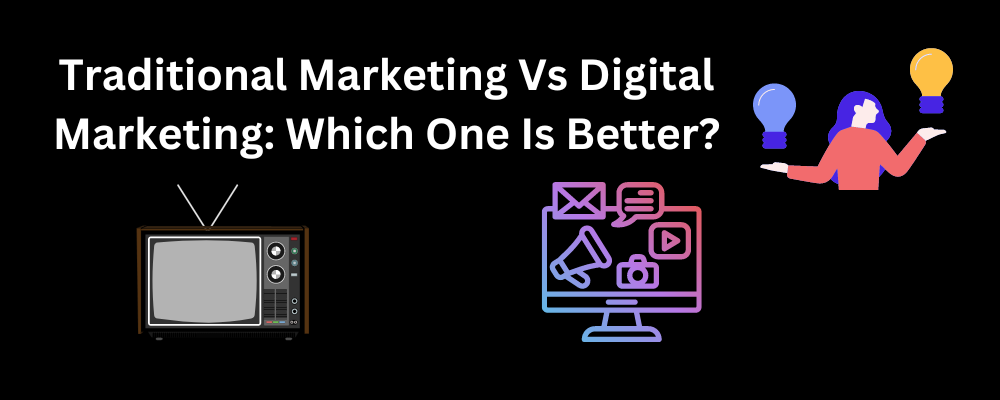Traditional marketing refers to marketing techniques that use offline channels to reach and engage with customers. These techniques include print ads in newspapers and magazines, billboards, television commercials, radio ads, and direct mail.
Digital marketing, on the other hand, refers to marketing techniques that use online channels to reach and engage with customers. These techniques include social media marketing, email marketing, search engine optimization (SEO), pay-per-click advertising, and online display advertising. Digital marketing allows for more targeted and personalized communication with customers, as well as the ability to track and analyze data to inform marketing strategies.
Importance of understanding the differences between Traditional and Digital Marketing
Understanding the differences between traditional and digital marketing is important for businesses because it allows them to effectively reach and engage with their target audience. Each approach has its own set of advantages and disadvantages, and choosing the right marketing mix will depend on the specific needs and goals of the business.
For example, traditional marketing techniques may be more effective for reaching a broad audience, particularly if the business is targeting older demographics who may not be as active online. On the other hand, digital marketing techniques may be more effective for targeting specific demographics or for reaching a more specific, targeted audience.
In addition, understanding the differences between traditional and digital marketing can help businesses allocate their marketing budget more effectively and make informed decisions about the types of marketing strategies they should pursue. By considering both traditional and digital marketing approaches, businesses can create a comprehensive marketing strategy that effectively reaches and engages their target audience.
Examples of traditional marketing techniques
Some examples of traditional marketing techniques include:
- Print ads in newspapers and magazines: Print ads are a common form of traditional marketing, and can be found in a variety of publications. These ads can be in the form of display ads, classified ads, or inserts.
- Television commercials: Television commercials are a popular form of traditional marketing, and are often used to promote products or services to a broad audience.
- Radio ads: Radio ads are a form of traditional marketing that allows businesses to reach a targeted audience through local or national radio stations.
- Direct mail: Direct mail is a form of traditional marketing that involves sending promotional materials, such as flyers or brochures, directly to potential customers through the mail.
- Billboards: Billboards are large, physical advertisements that are placed in high-traffic areas, such as along highways or in busy city centers. They are often used to promote products or services to a broad audience.
Advantages of traditional marketing
Some advantages of traditional marketing include:
- Reach: Traditional marketing techniques, such as television commercials and billboards, have the potential to reach a large, broad audience.
- Tangible materials: Traditional marketing techniques often involve the use of tangible materials, such as flyers or brochures, which can be kept and referred to later by the recipient.
- Established channels: Traditional marketing channels, such as television and radio, have been around for a long time and are well-established, which can give businesses a sense of credibility and trustworthiness.
- Familiarity: Many people are familiar with traditional marketing techniques and may be more comfortable engaging with them, as they have been exposed to them for a long time.
- Ability to create an emotional connection: Traditional marketing techniques, such as television commercials, can often create an emotional connection with the audience, which can be effective in influencing purchasing decisions.
Disadvantages of traditional marketing
Some disadvantages of traditional marketing include:
- High costs: Traditional marketing techniques can be expensive, particularly if they involve the use of physical materials or airtime on television or radio.
- Limited targeting options: Traditional marketing techniques often have limited targeting options, making it difficult to reach specific demographics or target groups.
- Limited ability to track and measure effectiveness: It can be difficult to track and measure the effectiveness of traditional marketing techniques, making it harder to determine the return on investment (ROI) of these campaigns.
- Limited ability to personalize: Traditional marketing techniques often lack the ability to personalize messages and campaigns to individual consumers, which can make it harder to effectively engage with the audience.
- Limited flexibility: Traditional marketing campaigns can be difficult to adjust or change once they are in place, making it harder to adapt to changing market conditions or customer needs.
Examples of digital marketing techniques
Some examples of digital marketing techniques include:
- Social media marketing: Social media marketing involves using social media platforms, such as Facebook, Twitter, and Instagram, to reach and engage with customers. This can include creating and sharing content, running paid advertisements, and engaging with followers.
- Email marketing: Email marketing involves sending promotional or informational emails to a list of subscribers. This can include newsletters, promotional offers, and other types of emails.
- Search engine optimization (SEO): SEO involves optimizing a website and its content in order to rank higher in search engine results pages (SERPs). This can include optimizing content for specific keywords, improving the website’s structure and navigation, and building backlinks.
- Pay-per-click (PPC) advertising: PPC advertising involves placing ads on search engine results pages or other websites, and paying each time the ad is clicked.
- Online display advertising: Online display advertising involves placing ads on websites or social media platforms in the form of banner ads, video ads, or other types of media. These ads can be targeted to specific audiences based on factors such as location, demographics, and interests.
Advantages of digital marketing
Some advantages of digital marketing include:
- Low cost: Digital marketing techniques can be relatively low cost compared to traditional marketing techniques, particularly if the business is able to handle the marketing efforts in-house.
- Targeting options: Digital marketing techniques offer a wide range of targeting options, allowing businesses to reach specific demographics or target groups.
- Data analytics: Digital marketing techniques allow businesses to track and analyze data in real-time, giving them insights into the effectiveness of their campaigns and allowing them to make data-driven decisions.
- Personalization: Digital marketing techniques allow businesses to personalize their marketing efforts, using data to tailor messages and campaigns to individual consumers.
- Flexibility: Digital marketing techniques offer a high degree of flexibility, allowing businesses to quickly and easily adjust their marketing efforts in response to changing market conditions or customer needs.
- Greater engagement: Digital marketing techniques often allow for greater engagement with customers, through tactics such as social media marketing and email marketing. This can help businesses build stronger relationships with their audience and encourage brand loyalty.
Disadvantages of digital Marketing
Some disadvantages of digital marketing include:
- Potential for low engagement: Despite the potential for greater engagement, it can be difficult to effectively reach and engage with consumers through digital marketing techniques. This can be especially true if the business is not able to create compelling content or effectively use targeting options.
- Need for constant updates: Digital marketing techniques often require frequent updates and maintenance in order to be effective. This can be time-consuming and require dedicated resources.
- Security and privacy concerns: Digital marketing techniques rely on the collection and use of personal data, which can raise concerns about security and privacy. Businesses need to be transparent about their data collection and use practices and ensure that they are complying with relevant laws and regulations.
- Competition: The low barrier to entry for digital marketing means that there is a high level of competition, which can make it difficult for businesses to stand out.
- Dependence on technology: Digital marketing techniques rely on technology, which can be subject to technical issues or outages. This can disrupt marketing efforts and make it difficult for businesses to reach their audience.
Comparison of Traditional and Digital Marketing
Here is a comparison of traditional and digital marketing, including some pros and cons of each approach:
Traditional Marketing:
Pros:
- Can reach a broad, mass audience
- Often creates an emotional connection with the audience
- Uses established, familiar channels
- Can produce tangible materials
Cons:
- High costs
- Limited targeting options
- Limited ability to track and measure the effectiveness
- Limited ability to personalize
- Limited flexibility
Digital Marketing:
Pros:
- Low cost
- Wide range of targeting options
- Ability to track and analyze data in real-time
- Ability to personalize campaigns
- A high degree of flexibility
- Potential for greater engagement with customers
Cons:
- Potential for low engagement
- Need for constant updates and maintenance
- Security and privacy concerns
- High level of competition
- Dependence on technology
Conclusion
In conclusion, traditional and digital marketing are two distinct approaches to marketing that have their own set of advantages and disadvantages. Traditional marketing techniques, such as print ads and television commercials, are effective at reaching a broad, mass audience and can create an emotional connection with the audience. However, they can be expensive and have limited targeting options.
Digital marketing techniques, on the other hand, offer a wide range of targeting options and the ability to track and analyze data in real-time. They also allow for greater personalization and flexibility. However, they can be subject to low engagement and require frequent updates and maintenance.
It is important for businesses to consider both traditional and digital marketing approaches in order to create a comprehensive marketing strategy that effectively reaches and engages their target audience. By understanding the differences between the two approaches, businesses can allocate their marketing budget more effectively and make informed decisions about the types of marketing strategies they should pursue.





